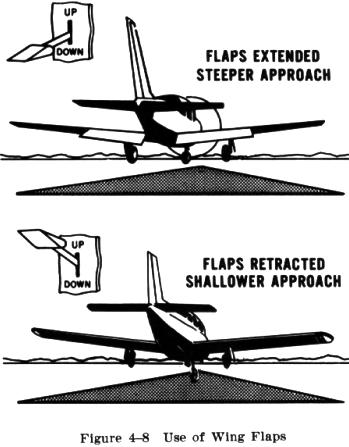| The flap operating control may be an electrical or hydraulic control
on the instrument panel, or it may be a lever located on the floor to the
right of the pilot's seat. In any case, the control may be placed in
various positions by the pilot; UP, which raises flaps if they are in an
extended position; NEUTRAL, which allows the flaps to remain in whatever
intermediate position they may be at that time; and DOWN, which lowers the
flaps if they are in the retracted or intermediate position (Fig. 4-8). In
addition to the flap operating control, there is usually an indicator
which shows the actual position of the flaps. On most general aviation
airplanes the extent of travel of the flaps is approximately 30 to 40
degrees.
Extending and retracting the flaps has a very noticeable effect on the
airplane's performance. With a constant power setting while maintaining
level flight, the airspeed will be lower with flaps extended because of
the drag they create. If power is adjusted to maintain a constant airspeed
while in level flight, the airplane's pitch attitude will usually be lower
with flaps extended.
When the flaps are extended, the airspeed should be at or below the
airplane's maximum flap extended speed (Vfe), because if they are extended
above this airspeed, the force exerted by the airflow may result in damage
to the flaps. If the airspeed limitations are exceeded unintentionally
with the flaps extended, they should be retracted immediately regardless
of airspeed.
It is extremely important that the pilot form the habit of
positively identifying the flap control before attempting to use it to
raise or lower the flaps. This will prevent inadvertently operating the
landing gear control and retracting the gear instead of the flaps,
particularly when on or near the ground. |
 |

